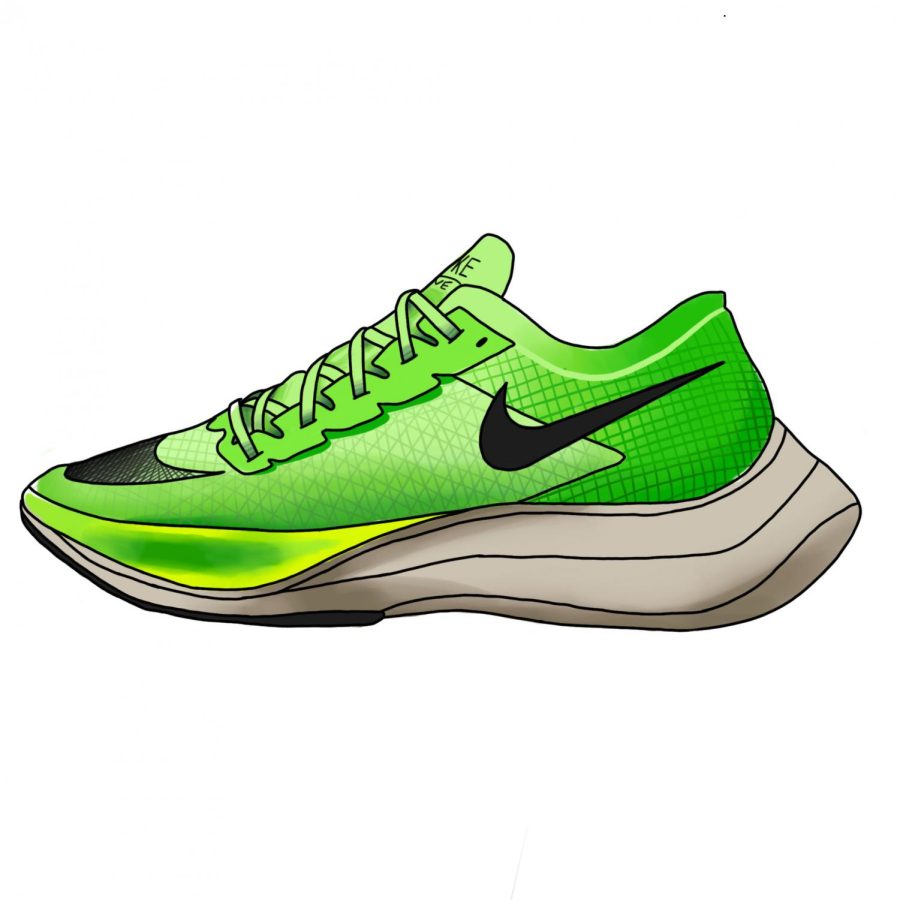World Athletics sets new regulations on running shoes
Graphic illustration by Alara Dasdan
The Nike Vaporfly’s traits include a 33 mm midsole and a carbon fiber plate, both of which correspond with a regulation of World Athletics.
February 26, 2020
On Oct. 12, 2019, Eliud Kipchoge ran the fastest marathon in world history — 1:59:40. However, this impressive time did not replace the marathon world record due to the massive amount of tools used to help him, including laser projected pacer lines, physical pacers by his side and Nike’s revolutionary Alphaflys.
The Alphaflys are the newest version of a series of running shoes released by Nike, which include the original Nike Vaporfly 4% and the updated Nike Air Zoom Vaporfly NEXT% — commonly referred to as Vaporfly. Because of these shoes’ ability to improve running economy by up to 6%, they have become a controversial subject in the running community.
With technology constantly developing, the line between athletic and technological advancement is becoming less clear, Vaporflys being a perfect example of this. World Athletics’ decision to create new regulations is a step in the right direction in the continuous argument of how much technology should be able to help athletes.
Starting on April 30, new rules set by World Athletics state that any shoe worn by a competing athlete must be available on open retail market for at least four months before being used in competition to ensure fairness to athletes who are not affiliated with certain brands. Additionally, midsoles on shoes cannot be thicker than 40 millimeters or contain more than one rigid embedded plate or blade of any material running through any part of the shoe.
Released in 2018, the Nike Vaporfly 4% marked significant leaps in running technology. With its lightweight VaporWeave upper and a carbon-fiber plate running through 35.7 millimeters of ZoomX cushioning foam midsole, the Vaporflys are the largest technological running shoe development in decades. The 4% in its name alludes to Nike’s proven claim that runners who wear this shoe can improve their running economy, or lactate threshold, by an average of four percent.
Following the Vaporfly 4% was the release of the Vaporfly NEXT%, which Nike claimed would increase a runner’s running economy by an average of five to six percent. The long-awaited Nike Alphafly NEXT%, used by Kipchoge in his sub-2 hour marathon, will be released to the public on Feb. 29 at a higher price point than the $250 Alphafly due to the nature of the shoe.
“I believe that the Nike Alphafly NEXT%s are really revolutionary running shoes,” sophomore Aryan Shah said. “Nike is doing phenomenal things with their running shoe technology, building off of what they’ve already established and accomplished.”
Largely publicized for their significance in BREAKING2, Nike’s goal to break the two-hour marathon, the Vaporfly has been a subject of conversation in the running community for the past two years. With the recent occurrence of Kipchoge’s record marathon time wearing the new Alphaflys, running shoe regulations are being questioned more than ever before.
On Jan. 31, the use of Vaporfly and Alphaflys during official races was banned by World Athletics, due to being considered “technological doping.” However, this was only due to their inability to meet the new regulations set by World Athletics that day.
“For events moving forward, I am glad that World Athletics has placed restrictions on the manufacturing of competitive shoes to create a more even playing field,” said Brad Wick, coach of the San Jose State University cross country team. “The Alphafly, I believe, falls in the new legal guidelines, and I am sure that will become the new norm with all competitive shoe companies.”
Of course, Nike along with other running shoe companies have been carefully following these new rules, as shoes similar to the Vaporfly are the future of long distance running.
The Vaporfly situation is very similar to the 2008 case involving the LZR Racer swimsuit, most famously worn by Michael Phelps. Athletes who wore this full-body swimsuit broke 13 world records in that March alone. After their impressive run at the Beijing Olympics, the suit was banned in 2009 by the International Swimming Federation, (FINA), who decided to enforce a ban on body-length swimsuits along with creating more swimsuit restrictions to prevent future cases of technological doping. Since then, the LZR Racer has been modified to meet the new criteria.
“Just like a few years ago when they banned the special swimsuits, I think that it was a good idea to put regulations on shoes,” Wick said. “Otherwise, where do the limits of technological advancement end?”
In this age of technology and constant development, it can be hard to take a step back and consider where to draw the line between what should be considered technological doping and what should not. While there is no definite answer, enforcing regulations and rules are a positive and crucial effort in ensuring the authenticity of running.





























































